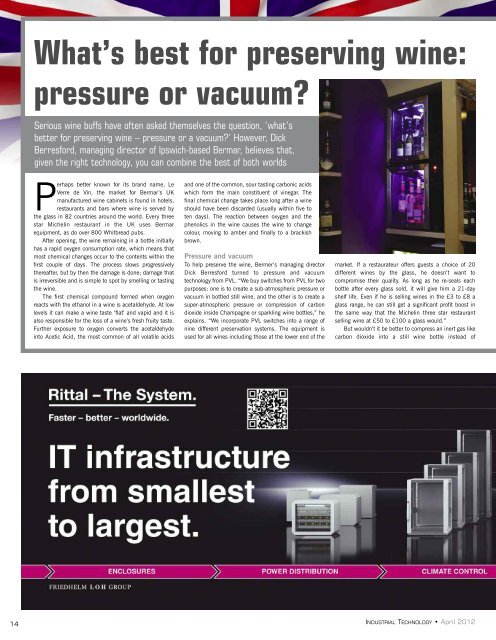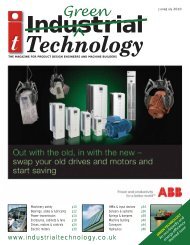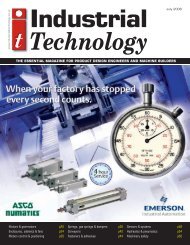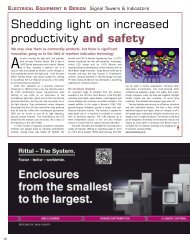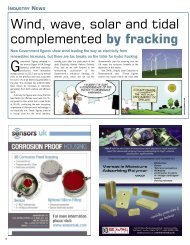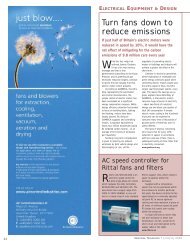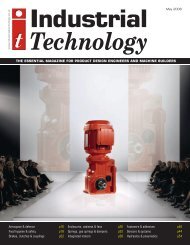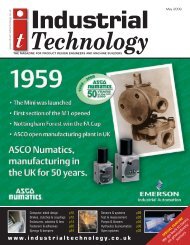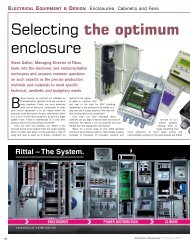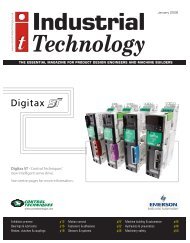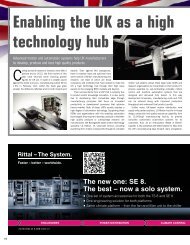machine building & automation - Industrial Technology Magazine
machine building & automation - Industrial Technology Magazine
machine building & automation - Industrial Technology Magazine
- No tags were found...
You also want an ePaper? Increase the reach of your titles
YUMPU automatically turns print PDFs into web optimized ePapers that Google loves.
What’s best for preserving wine:pressure or vacuum?Serious wine buffs have often asked themselves the question, ‘what’sbetter for preserving wine – pressure or a vacuum?’ However, DickBerresford, managing director of Ipswich-based Bermar, believes that,given the right technology, you can combine the best of both worldsPerhaps better known for its brand name, LeVerre de Vin, the market for Bermar’s UKmanufactured wine cabinets is found in hotels,restaurants and bars where wine is served bythe glass in 82 countries around the world. Every threestar Michelin restaurant in the UK uses Bermarequipment, as do over 800 Whitbread pubs.After opening, the wine remaining in a bottle initiallyhas a rapid oxygen consumption rate, which means thatmost chemical changes occur to the contents within thefirst couple of days. The process slows progressivelythereafter, but by then the damage is done; damage thatis irreversible and is simple to spot by smelling or tastingthe wine.The first chemical compound formed when oxygenreacts with the ethanol in a wine is acetaldehyde. At lowlevels it can make a wine taste ‘flat’ and vapid and it isalso responsible for the loss of a wine’s fresh fruity taste.Further exposure to oxygen converts the acetaldehydeinto Acetic Acid, the most common of all volatile acidsand one of the common, sour tasting carbonic acidswhich form the main constituent of vinegar. Thefinal chemical change takes place long after a wineshould have been discarded (usually within five toten days). The reaction between oxygen and thephenolics in the wine causes the wine to changecolour, moving to amber and finally to a brackishbrown.Pressure and vacuumTo help preserve the wine, Bermer’s managing directorDick Berresford turned to pressure and vacuumtechnology from PVL. “We buy switches from PVL for twopurposes: one is to create a sub-atmospheric pressure orvacuum in bottled still wine, and the other is to create asuper-atmospheric pressure or compression of carbondioxide inside Champagne or sparkling wine bottles,” heexplains. “We incorporate PVL switches into a range ofnine different preservation systems. The equipment isused for all wines including those at the lower end of themarket. If a restaurateur offers guests a choice of 20different wines by the glass, he doesn’t want tocompromise their quality. As long as he re-seals eachbottle after every glass sold, it will give him a 21-dayshelf life. Even if he is selling wines in the £3 to £8 aglass range, he can still get a significant profit boost inthe same way that the Michelin three star restaurantselling wine at £50 to £100 a glass would.”But wouldn’t it be better to compress an inert gas likecarbon dioxide into a still wine bottle instead of14INDUSTRIAL TECHNOLOGY • April 2012


